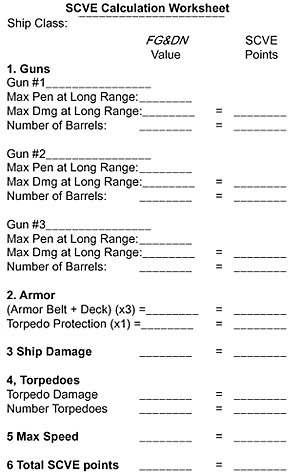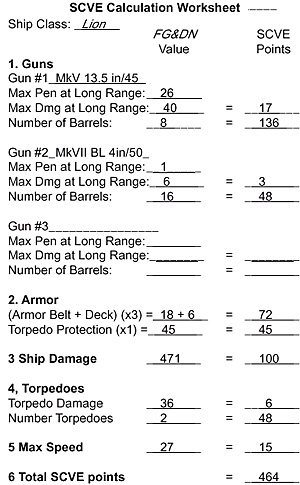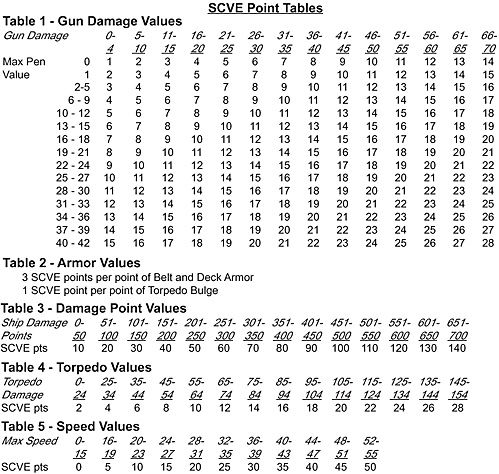The Ship Combat Value Equivalent (SCVE) system was developed a couple of years ago to give players more freedom in building scenarios at gaming conventions, primarily Cold Wars and Historicon. The goal of the system was to provide a simple method to allow players to ‘purchase’ their battle fleets according to a point cost that was based on their value as a combat vessel. The more capable the ship, the higher the cost. The resulting system allowed players to tailor their fleets to satisfy their individual tactical preferences or to fight battles with different ships that never saw action. This also relieved the game masters of any liability for choosing the ships that the players used in scenarios. (You can’t blame us for this one!) With the SCVE system, players are free to purchase their own ships and only their tactics and luck decide victory or defeat.
The SCVE system is based on five key factors that make up a ship’s combat characteristics and have the greatest effect in a tactical engagement.
- Ship’s Surface Gunnery (measured at long range by maximum penetration and maximum damage, regardless of deck or belt armor)
- Ship’s Armor Rating – Belt, Deck and Torpedo Bulge
- Ship’s Damage Points
- Ship’s Torpedo Capability
- Ship’s Maximum Speed
At present, the SCVE system supports only World War I-era (Fear God and Dread Nought) ships and technology. An expansion to support the World War II era (Command at Sea) is under development.
 The worksheet to the right can be used in calculating the SCVE points for a selected ship class. The process for determining the SCVE cost is as follows:
The worksheet to the right can be used in calculating the SCVE points for a selected ship class. The process for determining the SCVE cost is as follows:
1. Using the FG&DN Data Annex for the desired ship class, enter the appropriate data for each type of surface gun carried on board. Using the SCVE Gun Damage Table (Table 1) on page 8, determine the SCVE points for that gun type, regardless of the shell type. Multiply the Penetration/Damage SCVE value by the number of barrels of that gun type. The result is the SCVE value for that gun type. Repeat this step for each type of gun carried on board.
2. Enter the armor value for both belt and deck armor from the FG&DN Data Annex. Multiply the result by 3. Enter the torpedo bulge value and multiply by 1.
3. Enter the ship damage point value and use Table 3 to find the corresponding SCVE points.
4. Enter the damage points for the torpedo type carried on board and use Table 4 to determine the corresponding SCVE points. Multiply the result by the number of torpedoes carried on board.
5. Enter the maximum speed and use Table 5 to determine the corresponding SCVE points.
6. Add the subtotal SCVE point values for total ship class SCVE point cost.
Examples
Let’s look at two examples to see how the process works using a German V.125 class destroyer and a British Lion class battle cruiser.
For V.125 the process is fairly simple.
1. This ship carries one type of gun, the 10.5 cm SKL/45. At long range this gun has the maximum penetration of 1 and maximum damage of 6. Using Table 1, this results in a SCVE value of 3. Multiplied by the number of barrels, which is 3, results in a final SCVE value of 9 for the guns.
2. The armor belt is 0 and armor deck is 0, so total multiplied by 3 is 0. The torpedo bulge for this ship is 0. Added together, the total is 0.
3. The ship damage has 34 damage points. Using Table 3, the SCVE value is 10.
4. This ship carries the G/7 torpedo, which inflicts 56 damage points. Using Table 4, the SCVE value is 10. Multiplied by the number of torpedoes carried, which is 6, the final SCVE value is 60.
5. This maximum speed for this ship is 34 knots. Using Table 5, the SCVE value is 15.
6. So adding up all the final SCVE values we have:
- Guns = 9
Armor = 0
Damage = 10
Torpedoes = 60
Speed = 25
Total = 104 SCVE Points
Although the Lion-class battle cruiser is a much larger and more complex ship, the process for calculating the SCVE cost is still the same.
 1. This ship carries two types of guns:
1. This ship carries two types of guns:
- a) The MkV 13.5 in/45. At long range this gun has the maximum penetration of 26 and maximum damage of 40. Using Table 1, this results in a SCVE value of 17.
Multiplied by the number of barrels, which is 8, results in a final SCVE value of 136.
b) The MkVII BL 4 in/50. At long range this gun has the maximum penetration of 1 and maximum damage of 6. Using Table 1, this results in a SCVE value of 3. Multiplied by the number of barrels, which is 16, results in a final SCVE value of 48.
2. The armor belt is 18 and armor deck is 6, so when added together (24) and multiplied by 3 the result is 72. The torpedo bulge for this ship is 45. Added together, the total is 117.
3. The ship has 471 damage points. Using Table 3, the SCVE value is 100.
4. This ship carries the Whitehead 21 in MkII torpedo, which inflicts 36 damage points. Using Table 4, the SCVE value is 6. Multiplied by the number of torpedoes carried, which is 8, the final SCVE value is 48.
5. This maximum speed for this ship is 27 knots. Using Table 5, the SCVE value is 15.
6. So adding up all the final SCVE values we have:
- Guns = 136 + 48 = 184
Armor = 117
Damage = 100
Torpedoes = 48
Speed = 15
Total = 464 SCVE Points
So if we provide each player 500 SCVE points, a player could purchase either a single battle cruiser for 464 points or four destroyers for 416 points. If playing as part of a team, any left over points should go to a team pool to help either purchase another destroyer or two, or upgrade the type of capital ship from a battle cruiser to battleship. When putting the SCVE system together, we were primarily concerned with letting players have more of a say in selecting their ships for convention game play. Part of the impetus for the SCVE system came from a tournament play we attempted a few years ago: GUTS (Gunnery, Torpedoes and Speed). The idea was to have four divisions of four destroyers from various navies square off against each other.
The two winners and two losers of the first match faced each other using their surviving forces. So if you were too aggressive in the first battle, you could be crippled for the second. However, if you were not aggressive enough, then you could lose the first battle to begin with.
With ‘matched sets’ still resonating, I looked at trying to find an easy, yet accurate way to ‘purchase’ a match set and make for even game play. The only factor influencing the forces would be the tactical choices of the individual players. So the questioning began, initially limited to the FG&DN era – What was the purpose of a warship? What was it built to do? What attributes was it given to achieve its purpose? From the offensive viewpoint, warships carried guns and torpedoes. From a defensive viewpoint, warships have damage points and armor. A ship’s speed supports both perspectives.
Command and control attributes were left out, since those rules are optional. These five attributes -- guns, torpedoes, armor, damage points, and speed -- became the SCVE factors.
The result of the SCVE calculations placed emphasis on the relative weight of the importance of that factor. For instance, the mission of the V.125 class torpedo boat is to swiftly run in and deliver torpedoes against enemy ships. Almost 60% of the total cost of the V.125 is the torpedoes and 25% is speed. On the other hand, the Lion class battle cruiser is meant to seek out and destroy enemy ships by gunfire while being able to survive limited return fire during an engagement. Not surprisingly, the battle cruiser’s guns are over 40% of the total cost and armor almost another 30%.
The SCVE system allows players to build fleets based on any ship data currently in the FG&DN annexes. We’ve had great fun using the SCVE system, whether we were providing a ‘used ship lot’ and letting players purchase their fleets from available miniatures provided by the Admiralty Trilogy Team, or letting players bring in their own miniatures based on a predefined point limit.
In both cases, we had a good time observing the differences in ship selection and tactical planning when players were given some creative freedom. We tied the latter option together with a ship miniature ‘beauty’ contest to let players bring their own miniatures to use and show off what they had put together in their own ‘home fleets’. The results were very impressive.
While the SCVE system is not a very historical method for defining Fleet compositions, it does reflect some of the give-and-take considerations in deciding which ships, with what capabilities will be purchased. Do you buy a few big battleships or a mass of torpedo boats? The choices and decisions have always been interesting to observe. In fact, economic considerations were a major feature in the development of the Le Juene Ecole theory, which held that massed torpedo boats were just as effective and much cheaper than expensive battleships in defending the shores of France and her colonies. This is a question that still plagues governments and naval planning staffs even today.
With the SCVE system players now have a method to create balanced fleets and wage war with one another on an even keel without the worries of tax laws and interest rates. Just decide on the point total per player or per team, select your ships from available counters or miniatures, fill out your ship forms and get underway to go in harm’s way. Good luck and good hunting!

BT
Back to The Naval Sitrep # 25 Table of Contents
Back to Naval Sitrep List of Issues
Back to MagWeb Master Magazine List
© Copyright 2003 by Larry Bond and Clash of Arms.
This article appears in MagWeb.com (Magazine Web) on the Internet World Wide Web.
Other military history and related articles are available at http://www.magweb.com